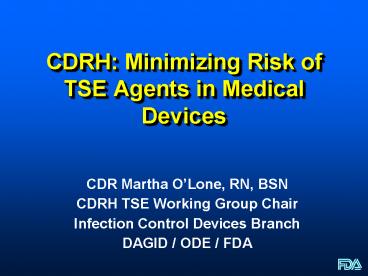CDRH: Minimizing Risk of TSE Agents in Medical Devices - PowerPoint PPT Presentation
1 / 12
Title:
CDRH: Minimizing Risk of TSE Agents in Medical Devices
Description:
Neurological Devices/General Surgical Instruments. In Vitro Diagnostic Devices. 4 ... General Surgical instruments (scalpels, scissors, biopsy forceps, retractors) 8 ... – PowerPoint PPT presentation
Number of Views:45
Avg rating:3.0/5.0
Title: CDRH: Minimizing Risk of TSE Agents in Medical Devices
1
CDRH Minimizing Risk of TSE Agents in Medical
Devices
- CDR Martha OLone, RN, BSN
- CDRH TSE Working Group Chair
- Infection Control Devices Branch
- DAGID / ODE / FDA
2
Center for Devices and Radiological Health
- Ensure medical device safety and
effectiveness - Reduce unnecessary exposure to radiation from
medical, occupational and consumer products
3
Objective
- Overview of CDRH Measures to Minimize Risk of TSE
Agents in Medical Devices - Implanted Medical Devices
- Neurological Devices/General Surgical Instruments
- In Vitro Diagnostic Devices
4
CDRH Procedures/Approach
- Premarket review 510(k), IDE, PMA
- Postmarket surveillance
- Scientific Research
- Field Inspections
- Communicate with industry, health professionals,
consumers and foreign governments through
letters, guidances and public meetings
5
Implanted Medical Devices
- Implants devices with human/bovine tissue
- Human- cellular wound dressings, human dura
mater, bone void fillers, human collagen - Animal- absorbable hemostatic agents, dura
substitutes, pericardial valves, collagen implants
6
Minimizing TSE Risk for Implanted Medical Devices
- Premarket review
- Source, Manufacture, Sterilization
- Guidance
- Human (CBER and CDRH)
- Animal (CDRH) General/Specific
- Postmarket Surveillance
- Inspections
7
Minimizing TSE Risk for Neurological-General
Surgical Medical Devices
- Examples
- Neurological medical devices (cranial drill bits)
- General Surgical instruments (scalpels, scissors,
biopsy forceps, retractors)
8
Approaches Used to Minimize TSE Risk for Medical
Devices
- Premarket review
- Guidance-1996 Labeling for Reuse,
- Work with CDC- to develop recommendations
- Research- Decontamination of medical devices
exposed to TSE CBER/CDRH
9
In Vitro Diagnostic Devices
- Future-Tests to aid in diagnosis of a patient
with variant CJD or infected and at risk for
developing CJD - For further questions contact the CDRH Office of
In Vitro Diagnostics - Sally Hojvat, Director of the Division of
Microbiology Devices 301-594-2096
10
Conclusions
- CDRH has taken action to minimize risk of TSE
transmission in medical devices in the following
areas - Premarket review 510(k), IDE, PMA
- Postmarket surveillance
- Scientific Research
- Field Inspections
- Communicating with industry, health
professionals, consumers and foreign governments
through letters, guidances and public meetings
11
(No Transcript)
12
CDRH Guidance Documents
- 1996 FDA Guidance Labeling Reusable Medical
Devices for Reprocessing In Health Care
Facilities FDA Reviewer Guidance - 1998 Guidance for Industry- Medical Devices
Containing Materials Derived from Animal Sources
(Except for In Vitro Diagnostic Devices)
http//www.fda.gov/cdrh/ode/88.html - 2000 Guidance Document for Dura Substitute
Devices Guidance for Industry,
http//www.fda.gov/cdrh/ode/1152.html - 2003 Class II Special Controls Guidance Document
Human Dura MaterGuidance for Industry and FDA
Staff http//www.fda.gov/cdrh/ode/054.html































